Data-Driven Marketing Explained: How to Build Strategies That Actually Work
Understand what data-driven marketing is and how to build effective strategies. Get practical frameworks, and learn how to implement it.

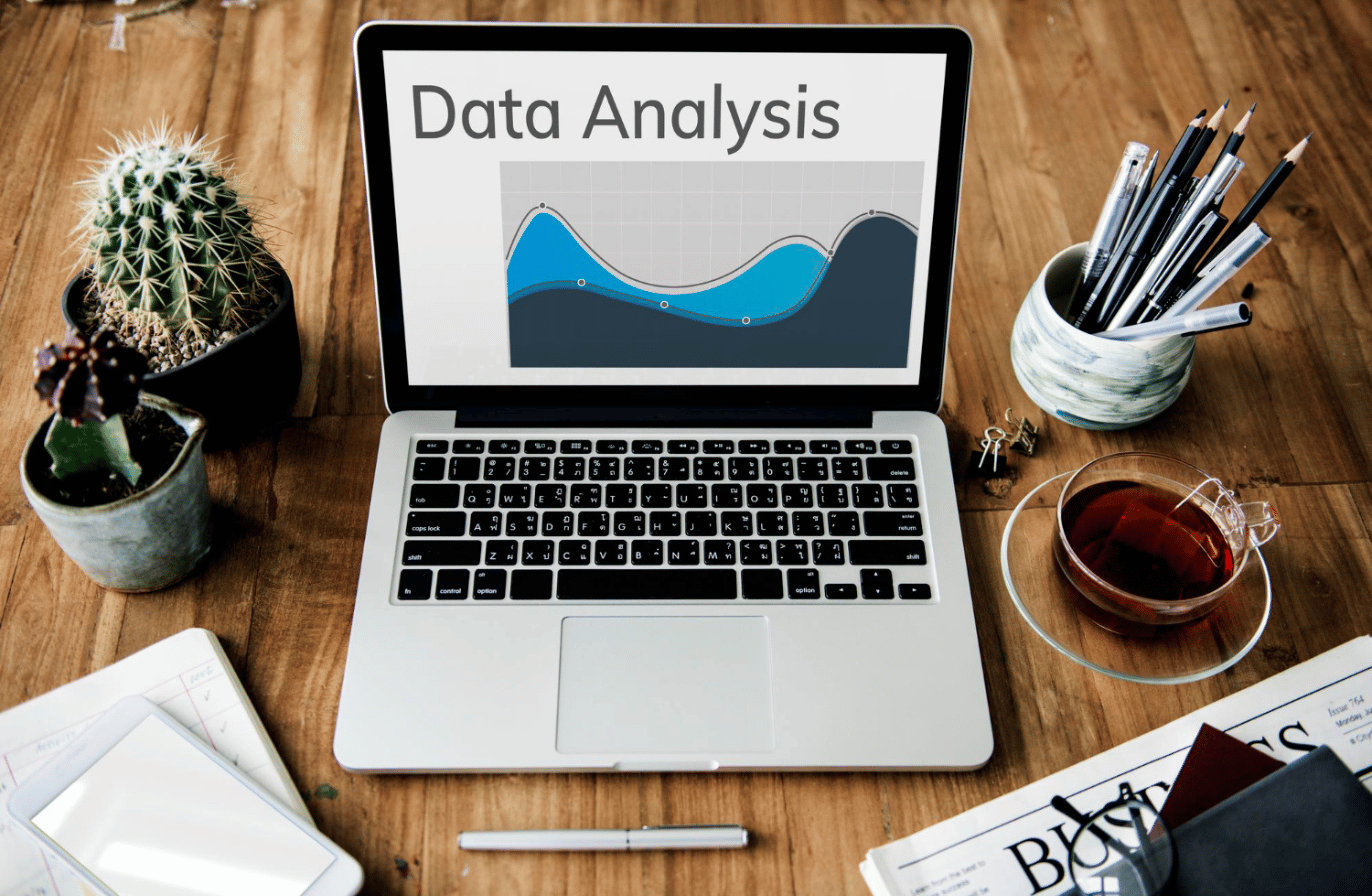
Data-driven marketing has transformed how businesses connect with their audiences, moving beyond guesswork to strategic decisions backed by real insights.
Today's social media marketing requires understanding what metrics reveal about audience behavior, content performance, and campaign effectiveness. Feeling overwhelmed by data collection and interpretation?
Don't worry. This guide provides practical examples, step-by-step frameworks, and real-world insights to help you build and implement a data-driven approach that delivers measurable results.
Key takeaways
-
How to gather, analyze and interpret data:Collect relevant quantitative and qualitative data aligned with your marketing goals, segment it by audience type, and interpret patterns to guide decision-making.
-
Essential data-driven marketing techniques: Leverage techniques like A/B testing, predictive analytics, and personalization to optimize campaign performance and customer engagement.
-
How to build a data-driven marketing framework: Build a solid framework by aligning teams, integrating the right tools, and establishing a continuous feedback loop to improve strategies over time.
What is data-driven marketing?
Data-driven marketing is the practice of using insights from data to inform every aspect of a marketing strategy. Instead of relying on intuition, marketers analyze metrics like social media audience behavior, content performance, and campaign results to guide decisions.
This approach helps teams understand what resonates, identify gaps, and continuously optimize for better outcomes, making marketing efforts more targeted, efficient, and impactful.
How does data-driven marketing differ from traditional marketing?
While traditional marketing often relies on broad demographics, creative intuition, and one-size-fits-all campaigns, data-driven marketing is rooted in precision and personalization.
Here's how they differ:
- Audience targeting: Traditional marketing segments audiences broadly (e.g., "women aged 25–40"), while data-driven marketing uses behavior, preferences, and platform-specific interactions to build detailed personas.
- Decision-making: Traditional strategies lean on experience and past campaign performance. Data-driven strategies, in contrast, adapt in real time based on current data streams.
- Measurement: In traditional marketing, success is often tracked by reach or brand awareness alone. Data-driven marketing measures performance across the entire funnel — from impressions to conversions and retention.
Think of it as shifting from broadcasting to narrowcasting: instead of pushing out a message and hoping it sticks, data-driven marketing ensures you're delivering the right message to the right person, at the right time.
Why is data-driven marketing essential for organizations oriented toward growth?
- Improved ROI and resource allocation: Data shows what's working and what's not, so teams can double down on high-performing channels.
- Enhanced customer experiences and satisfaction: With the right data, marketers can personalize messaging and offers, leading to higher satisfaction and stronger loyalty.
- More accurate targeting and reduced waste: Behavioral and performance data help focus efforts on high-intent audiences, improving engagement while reducing waste.
- Faster adaptation to market changes: Real-time insights allow teams to react quickly to shifts in audience behavior, trends, or platform changes.
- Competitive advantage in crowded markets: Data empowers faster, smarter decisions — giving brands a strategic edge in crowded spaces.
How to gather, analyze, and leverage data?
Success in data-driven marketing comes down to three key phases:
- Collecting the right information
- Turning data into actionable insights
- Applying findings to improve your strategy
Let's walk through each step so you can build a system that actually moves the needle.
Collection phase: sources and methods
Any data-driven marketing strategy starts with gathering information from various sources. While you could manually track social media KPIs using the native analytics of different platforms, it quickly becomes overwhelming and time-consuming.
Smart data-driven marketers use automated reporting to see the bigger picture, while freeing up time to focus on analysis and strategic optimization.
Here are a few tools that support your data gathering efforts:
- Website analytics — Google Analytics provides insights into user behavior, traffic sources, and conversion paths.
- CRM systems — Platforms like HubSpot track customer interactions throughout the entire buyer journey, helping with social media attribution.
- Email marketing platforms — Tools like Mailchimp and Klaviyo offer detailed engagement metrics that reveal what content resonates with your subscribers and when they're most likely to take action.
- Social media analytics tools — For comprehensive cross-platform performance tracking and competitor analysis, tools like Socialinsider aggregate data from multiple networks, making it easier to spot trends and benchmark your performance. It pulls metrics from Instagram, TikTok, Facebook, YouTube, and LinkedIn into single reports, so you don't have to switch between different platforms. You can also track several competitors simultaneously, comparing posting frequency, engagement, follower growth, and message efficiency.
For example, here's an overview of Glossier's performance across Instagram and TikTok, showing how different metrics paint a complete picture of their social media engagement strategy:
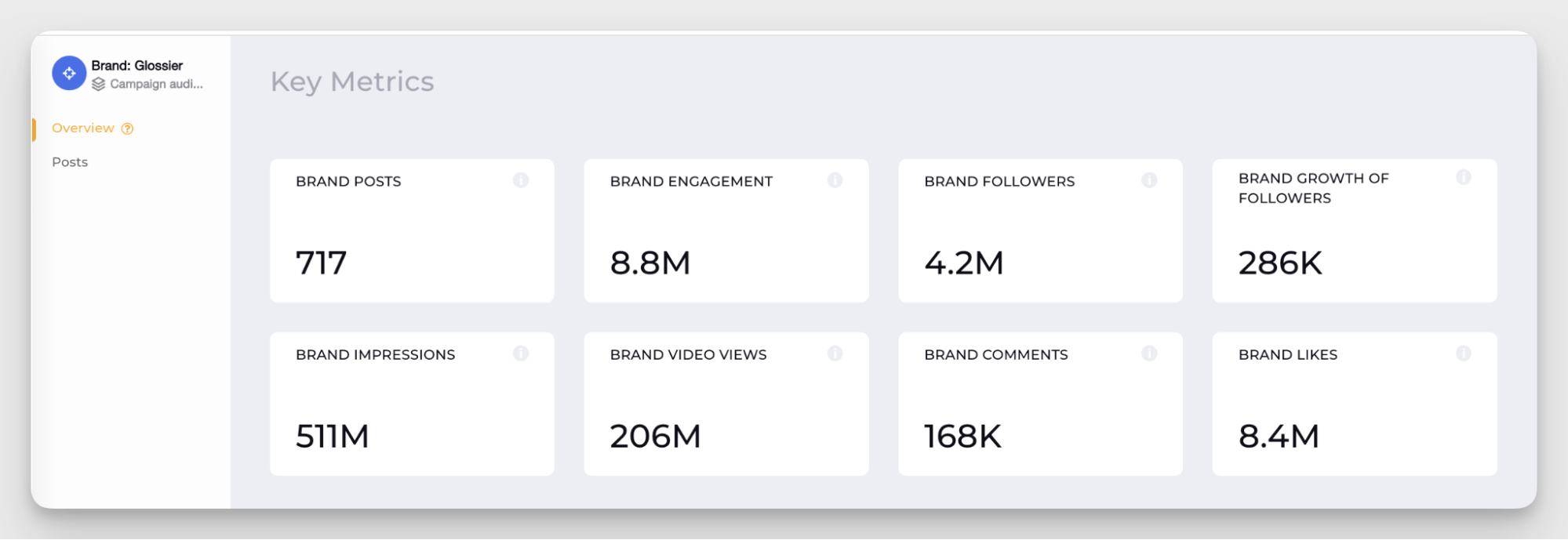
And for broader context, here's how their data stacks up against competitors, revealing insights about competitive benchmarking in the beauty industry:
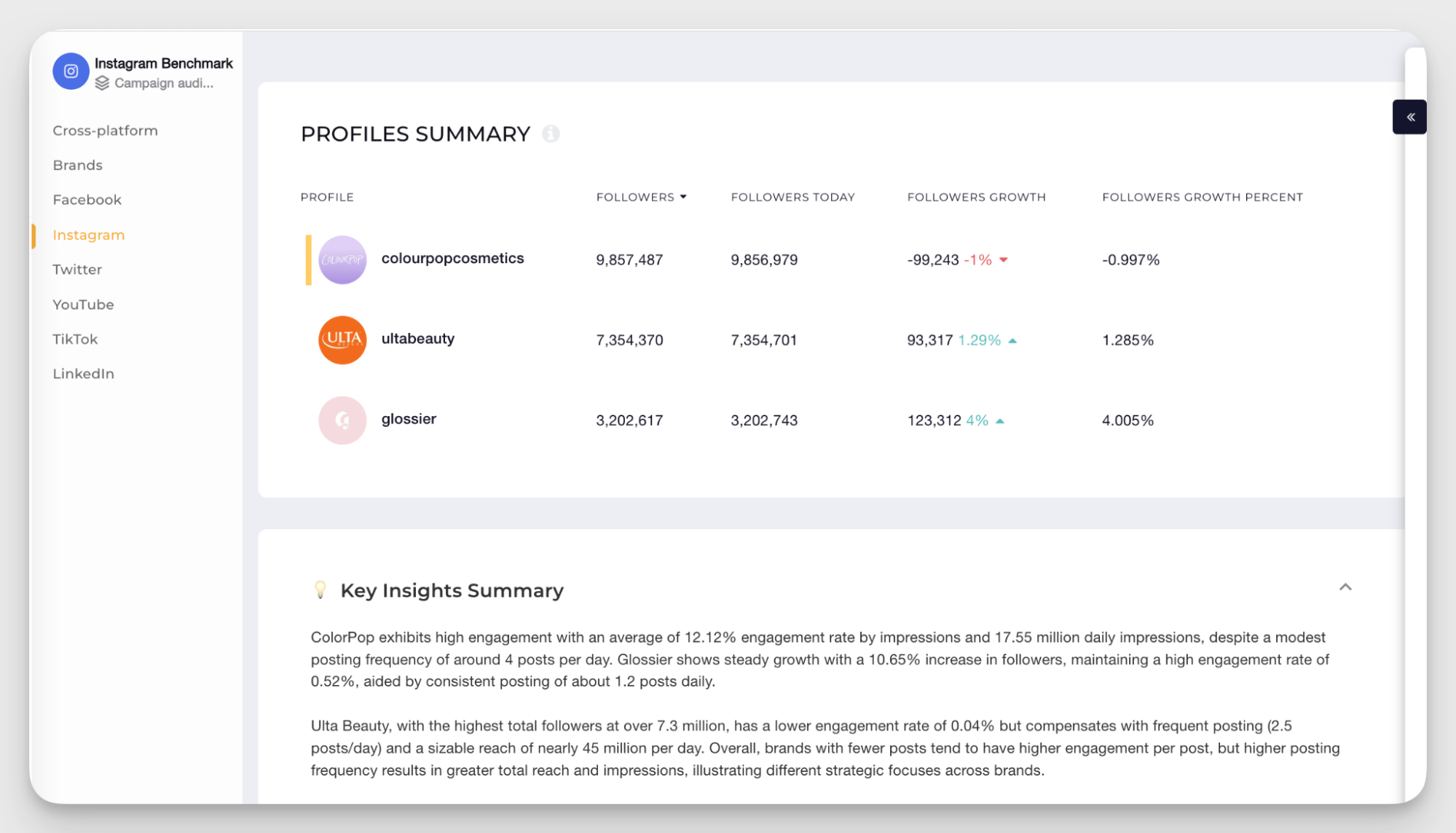
- Social listening tools — Platforms like Awario monitor brand mentions and sentiment across social platforms.
- Google Ads — Campaign performance data, keyword insights, and audience demographics help you understand which paid strategies drive results and how to allocate your budget.
- Facebook Ads Manager — Detailed demographic data and social media conversion tracking reveal which audience segments respond best to your messaging and creative approaches.
Choose tools that are intuitive and integrate well together. When your data sources can talk to each other, you'll spot patterns that would be hard to notice by looking at each platform in isolation.
Analysis phase: turning raw data into actionable insights
Raw numbers don't tell stories, but insights do. The analysis phase is about asking the right questions and finding patterns that inform your next moves.
When examining engagement data, look beyond surface-level metrics. For instance, when looking at this engagement chart for Glossier, we see that Instagram carousels perform best for the brand, generating 56% of total engagement compared to 26% for Reels and 17% for single images:
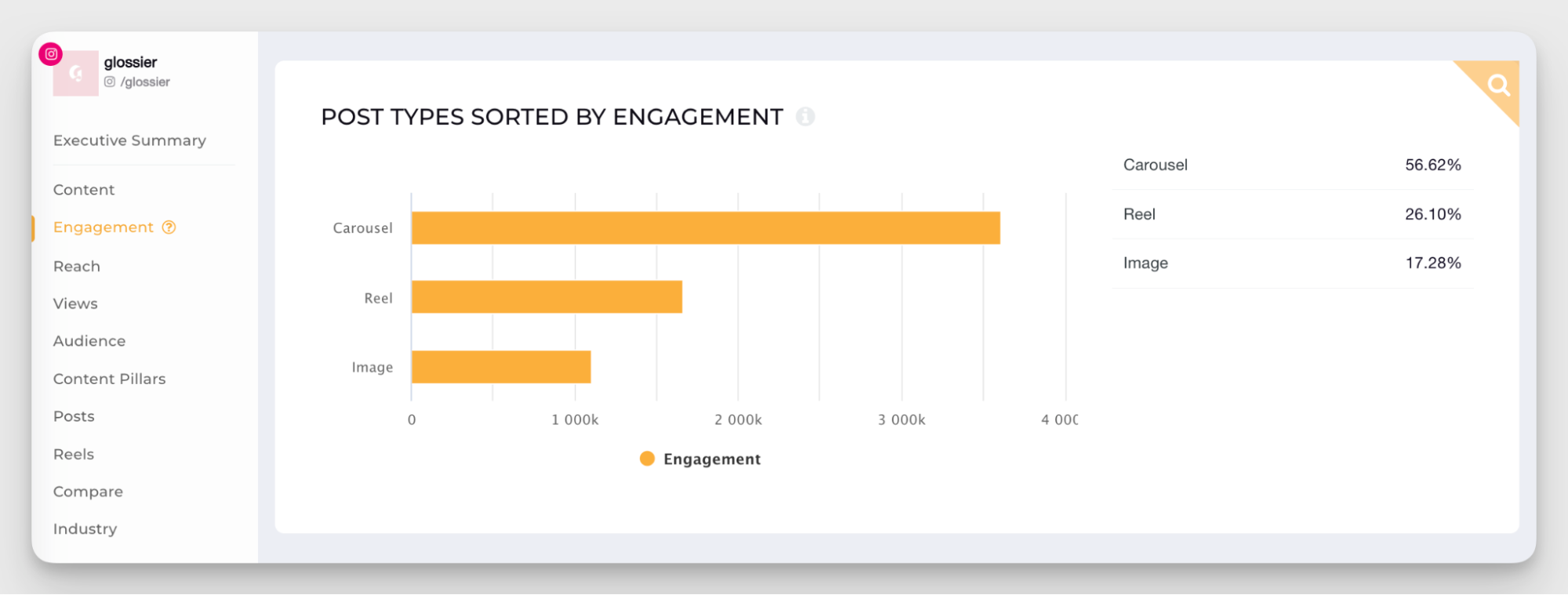
This insight should influence Glossier's future content strategy. Rather than simply posting more content, they should prioritize carousel formats that allow for storytelling and product showcases.
Here's how to turn data into insights that matter:
- Look for patterns across longer periods — Don't just examine daily or weekly performance. Compare month-over-month and quarter-over-quarter trends to identify seasonal patterns or long-term shifts in audience behavior.
- Segment your audience data — General audience insights only tell part of the story. Break down performance by demographics, interests, and behaviors to understand which messages resonate with specific groups.
- Compare against benchmarks — Your metrics only have meaning in context. Use industry benchmarks and competitive analysis to understand whether your performance is strong or needs improvement.
- Connect the dots between platforms — Data-driven consumer insights emerge when you examine how audiences behave across touchpoints. For example, a customer might discover you on Instagram, research your website, and convert through email marketing.
Implementation phase: applying insights to marketing strategies
Analysis without action is just expensive reporting. You must take your insights and translate them into specific changes to your campaigns, content, and overall approach.
Start with quick wins that can be implemented immediately. If your data shows that carousel posts generate the highest engagement, adjust your content pillars to include more multi-slide stories. If certain times consistently drive better engagement, update your publishing schedule.
For larger strategic shifts, create a testing framework. Use A/B testing to validate insights before making major changes. This helps you confirm that what you're seeing in the data actually translates to improved results.
Budget allocation is another area that data-driven marketers can influence. When you know which channels, campaigns, and content types drive the best return, you can confidently shift resources toward what's working, maximizing social media ROI.
Measurement and optimization phase: the continuous improvement cycle
The most successful teams treat data-driven marketing as a continuous cycle of measurement, analysis, and optimization. This means regularly reviewing your social media metrics and being ready to pivot when needed.
Set up regular review cycles:
- weekly for social media tactical adjustments
- monthly for strategic reviews
- quarterly for major strategic pivots
- yearly for comprehensive social media audits and goal alignment
During these reviews, ask yourself: What's working better than expected? Where are we underperforming? What new patterns are we seeing in audience behavior?
Essential data-driven marketing techniques
The following four approaches help you build successful campaigns by understanding your audience, predicting outcomes, measuring impact, and improving results.
Customer segmentation and personalization
Customer segmentation means you stop treating all customers the same.
Modern segmentation goes far beyond basic demographics. You can segment based on purchase behavior, content engagement patterns, social media target audience characteristics, or lifecycle stage. For example, customers who frequently engage with educational content might respond better to how-to guides and tutorials, while those who engage with product showcases are likely closer to making a purchase decision.
The power of segmentation lies in personalization. When you understand each segment's needs and preferences, you can tailor everything from email subject lines to social media content. This targeted approach typically results in higher engagement rates, better conversion rates, and improved customer loyalty.
Predictive analytics and forecasting
Predictive analytics lets you use historical data to forecast trends and anticipate customer behavior rather than simply react to it. You can understand which content types will perform best, when your audience is most likely to engage, and which customers are at risk of churning.
While extremely helpful, social media forecasting is challenging due to platform limitations. Third-party social media apps usually limit follower data to the moment an account is added to the platform because of social network API restrictions.
But not all tools are created equal. Platforms like Socialinsider have built sophisticated estimation models to provide historical follower data that helps you understand long-term growth patterns.
This type of forecasting helps you understand whether current growth trajectories are sustainable and when you might need to adjust. In the Ulta Beauty example below, the data shows strong overall growth (29.8% increase) but declining momentum in net new followers, suggesting the need for strategy adjustments to maintain growth rates.
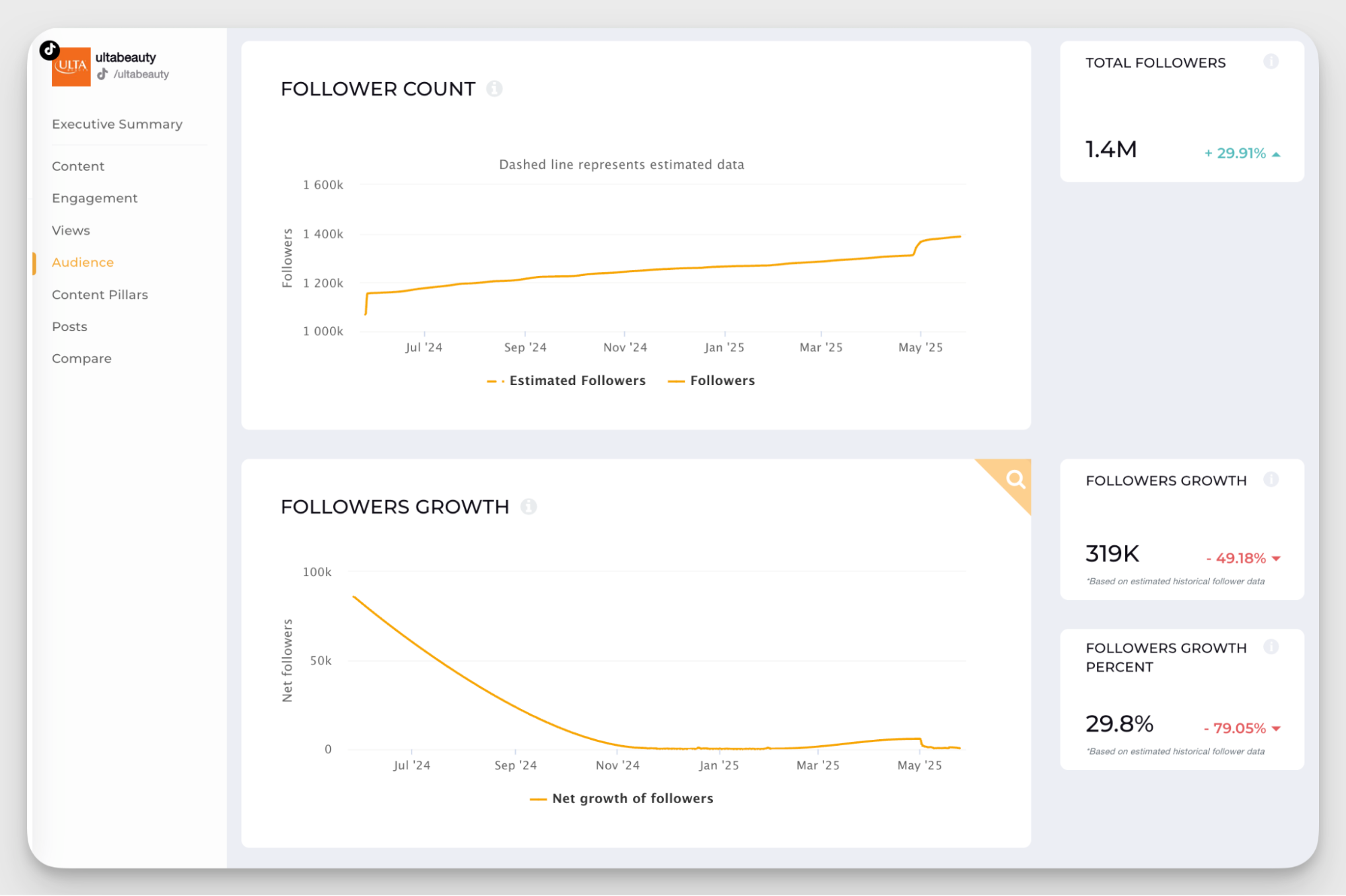
Attribution modeling
With so many channels of communication available, customers interact with brands across numerous platforms before making a purchase decision.
Attribution modeling helps you allocate budget more effectively and gives credit where it's due. A customer might discover your brand through a social media campaign, research on your website, receive email sequences, and finally convert through a retargeting ad. Attribution helps you understand the value of each point in that journey.
Different social media attribution models serve different purposes. First-touch attribution credits the initial interaction, last-touch credits the final touchpoint before conversion, and multi-touch models distribute credit across all interactions. Choose a model that aligns with your social media goals and customer journey complexity.
A/B testing and experimentation
Social media A/B testing eliminates guesswork. Rather than debating which approach might work better, you can test different versions and let the data decide. Testing variables include posting times, content formats, audience targeting and campaign messaging.
When testing on social platforms, ensure you account for algorithm changes that might affect results. Social media analytics tool can help you design and measure tests more effectively by providing historical data and benchmarks to compare results against.
How to build a data-driven marketing framework?
To build a successful data-driven marketing strategy, you need a clear plan to turn that data into real business results. Let's walk through the main steps you must take, complete with social media best practices.
Set clear, measurable objectives
Before you can measure success, you need to define what success looks like. Data-driven marketers align their metrics with specific business goals, creating a clear path from data collection to business impact.
Each stage in the customer journey requires different metrics and approaches to measurement. The framework below ensures you're tracking the right things at the right time.
Establish KPIs and metrics that matter for different goals
Awareness goals
Awareness metrics show whether your brand is reaching new audiences and expanding its visibility.
What to measure:
- Follower growth — Track how your audience is expanding across platforms. Look for consistent growth patterns and identify which content or campaigns drive the biggest spikes in new followers.
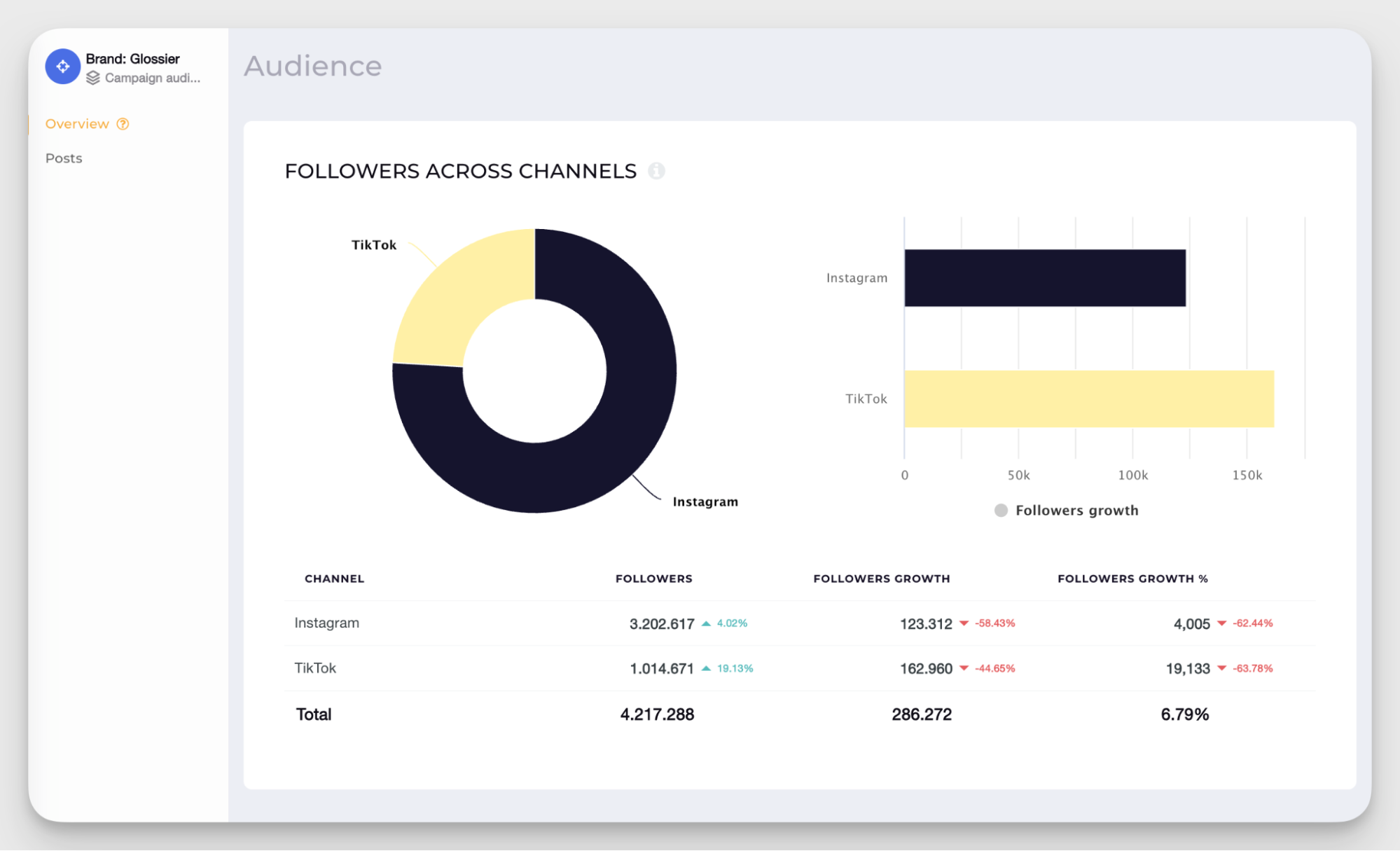
- Reach & impressions — Monitor how many people see your content and how often. This data reveals your content's potential impact and helps you understand audience behavior patterns.
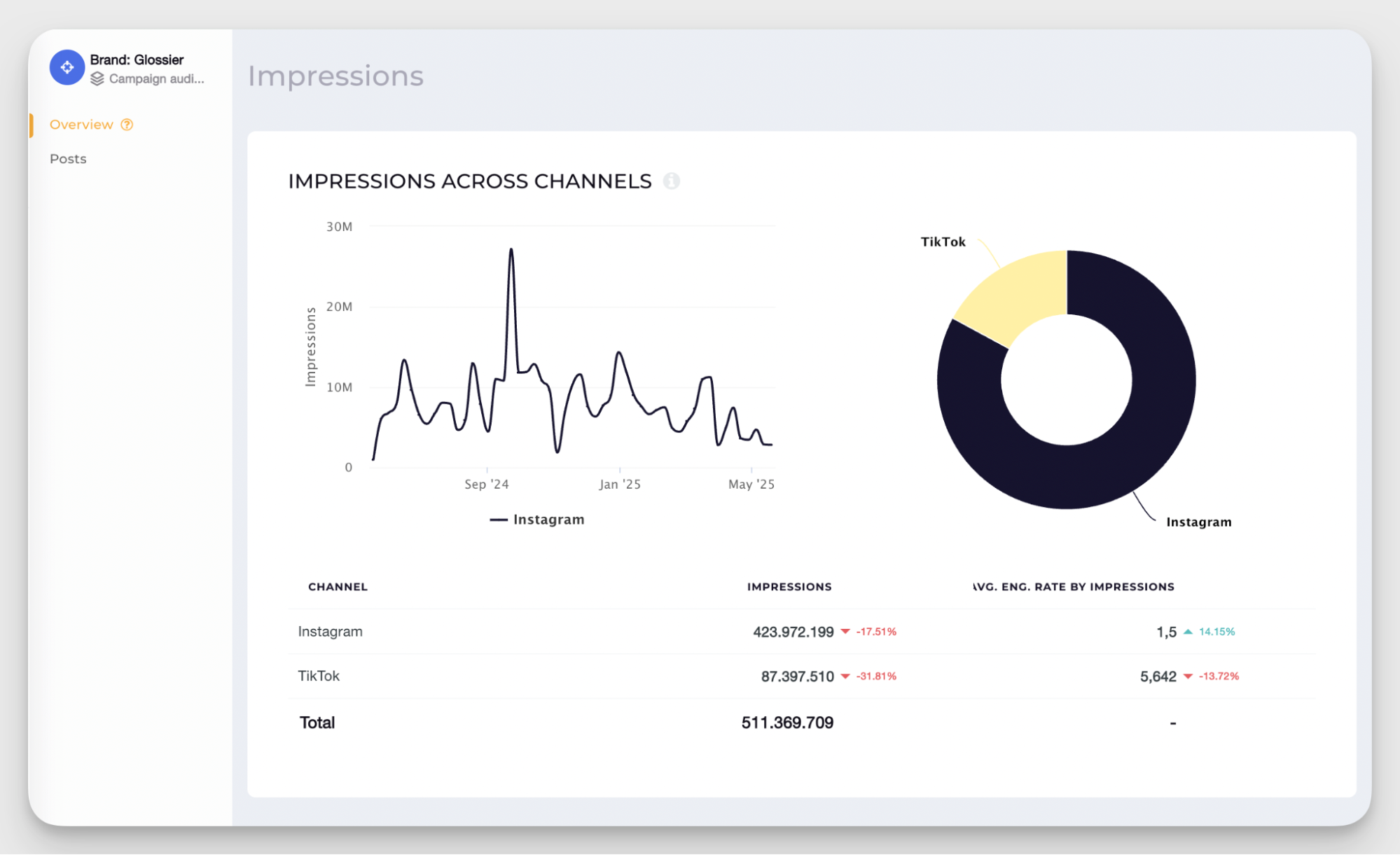
- Website traffic — Organic search traffic, direct visits, and referral traffic all indicate growing brand awareness and recognition.
Consideration goals
Consideration metrics reveal how deeply audiences engage with your brand and whether they're moving from passive awareness to active interest.
What to measure:
- Engagement across channels and content pillars — This reveals which topics and formats drive the strongest audience connection.
Looking at Glossier's engagement distribution, we see they generated 8.8M total engagement, with Instagram driving the majority compared to TikTok.
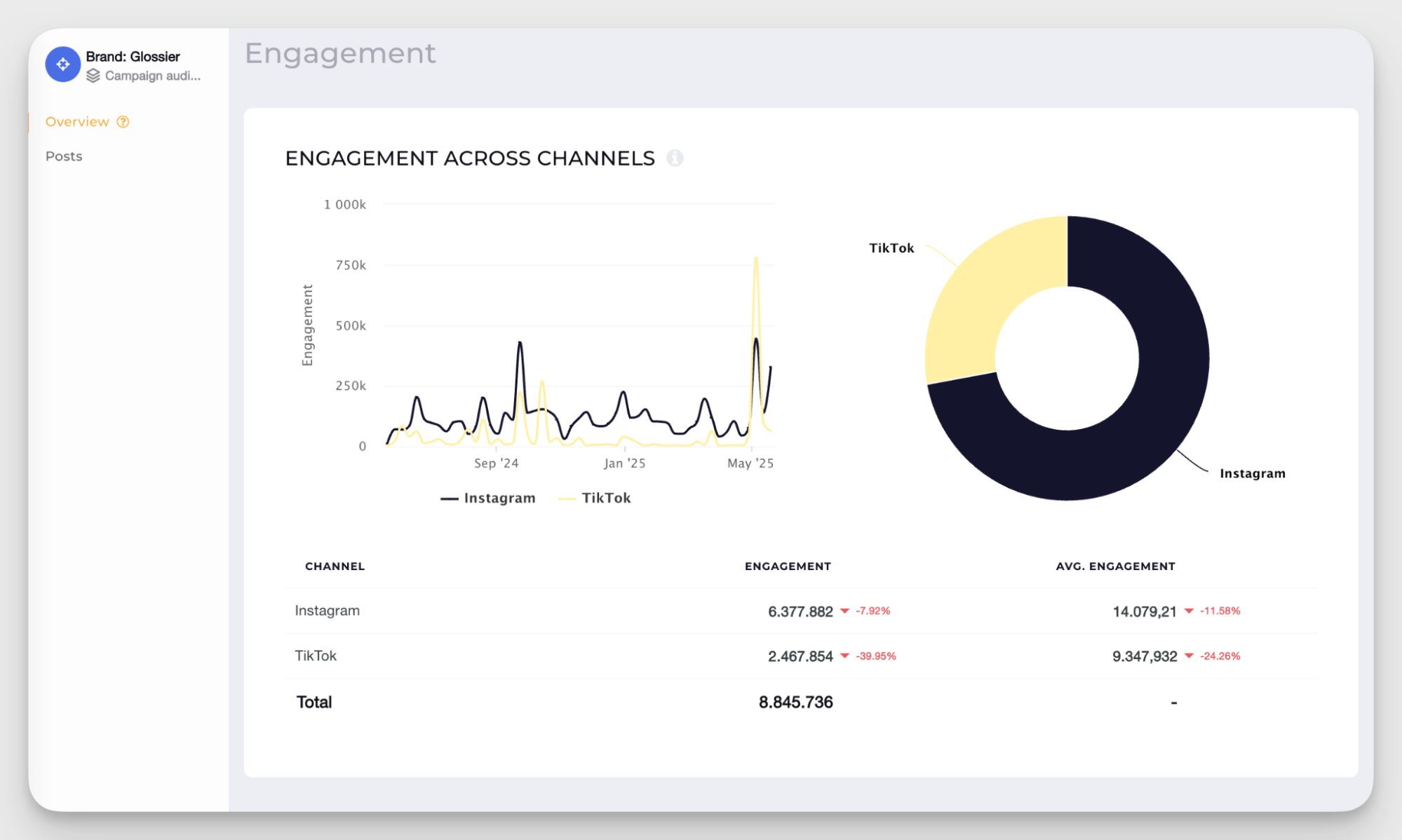
Breaking down performance by content pillars reveals which topics resonate most strongly.
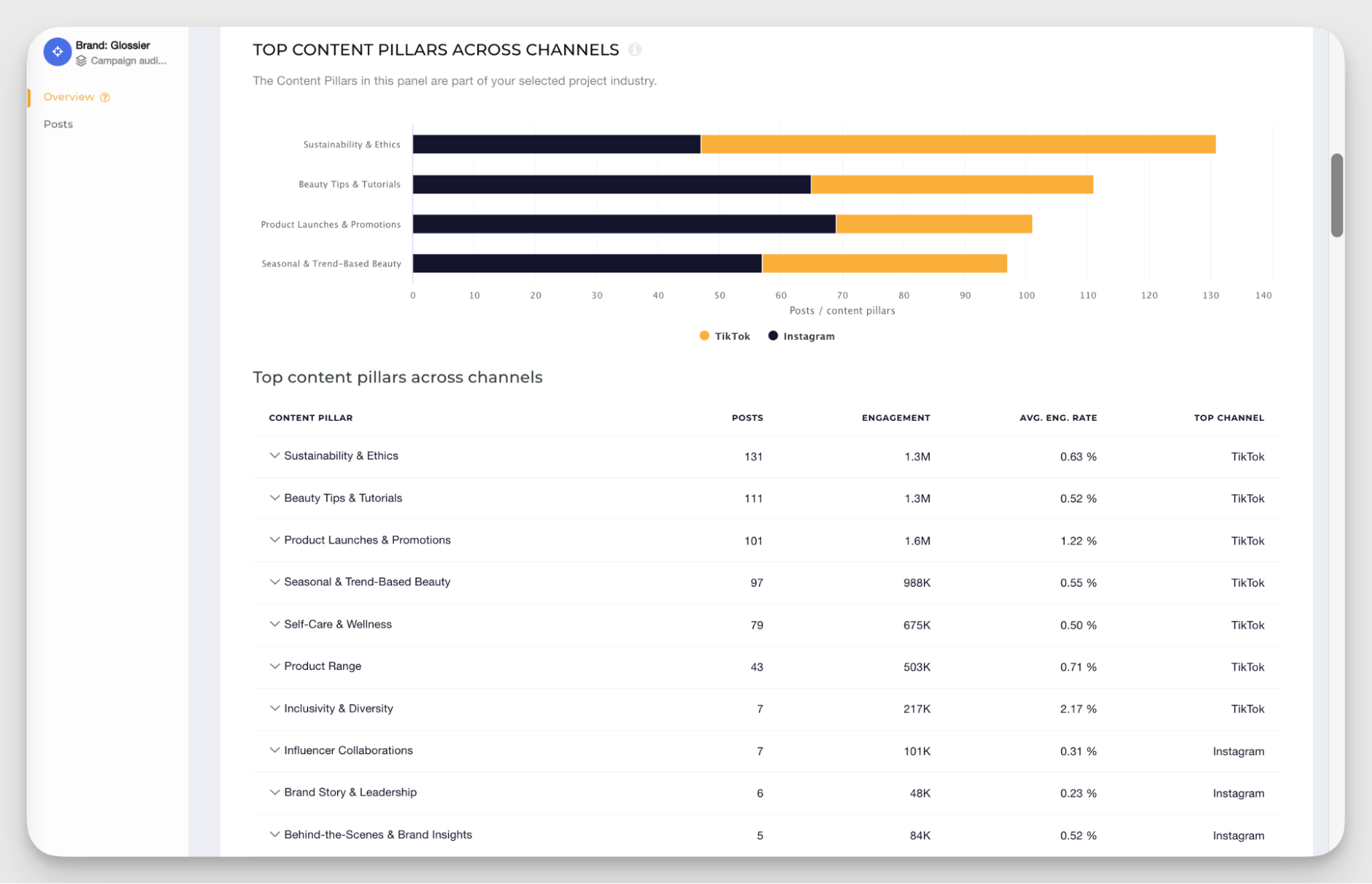
Comparing against competitors shows different strategic approaches to content themes. The competitive analysis below reveals engagement rates varying significantly by brand and topic, helping identify opportunities where Glossier could differentiate or double down on successful areas.

- Comments and shares — Comments show deeper audience investment, while shares extend your social media reach organically.
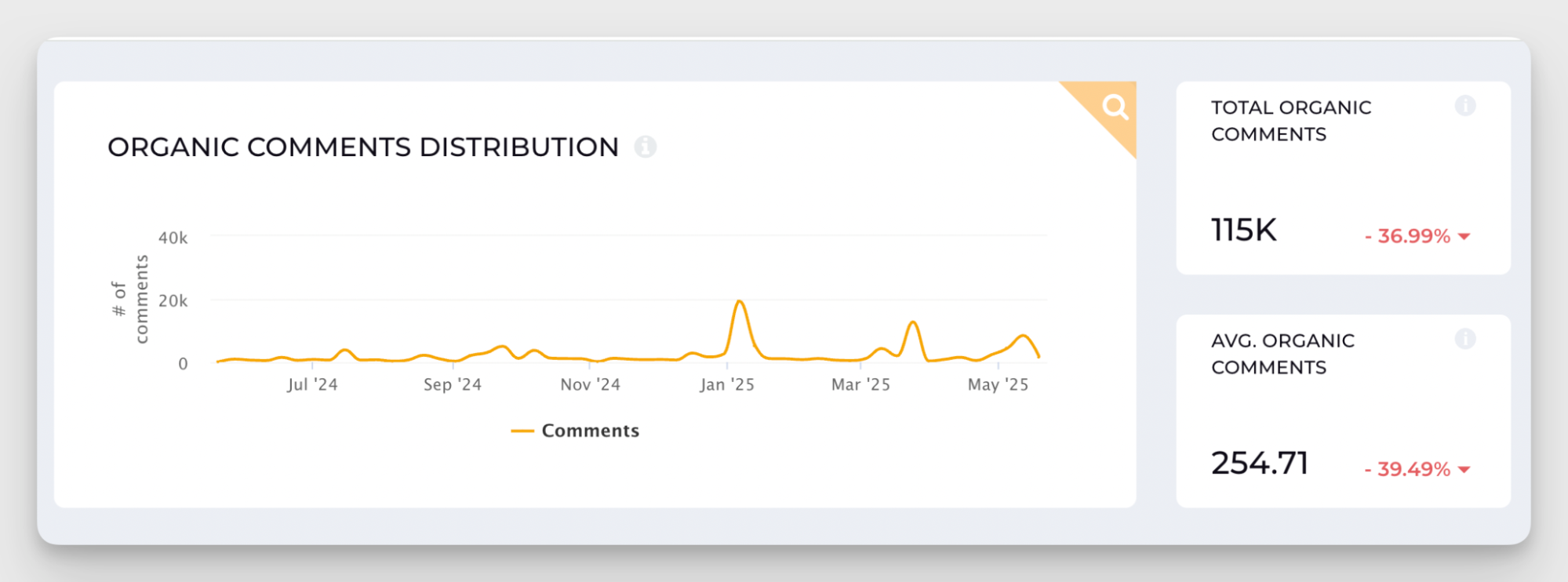
With Socialinsider, you can see the content that generated engagement spikes and use these insights for strategy optimization. You can understand whether high-performing posts were product-related, featured influencer collaborations, or tied to specific trends.
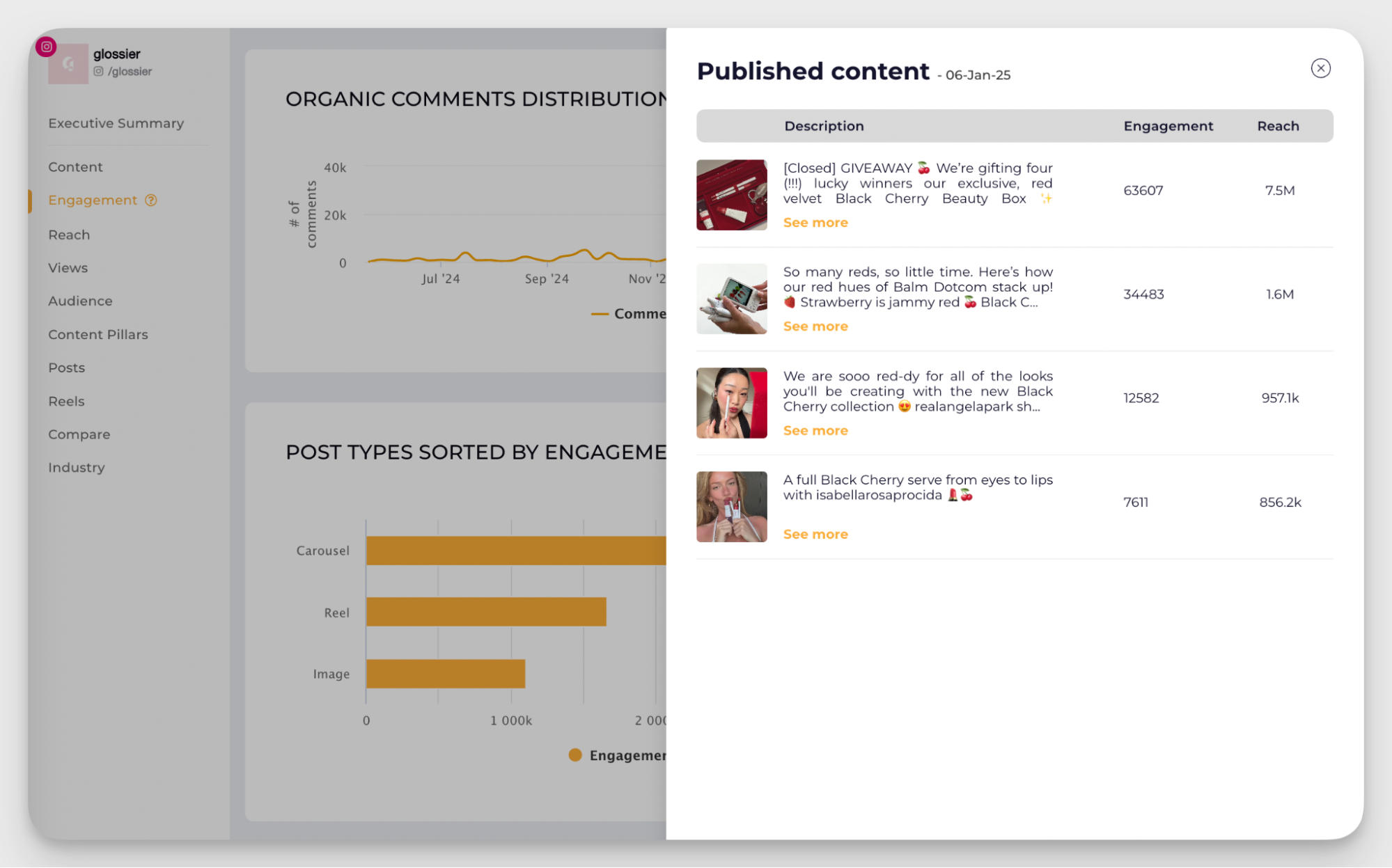
- Top-performing social media posts and blog articles — Identify which content formats and topics consistently drive engagement. This analysis helps inform your content strategy and resource allocation.
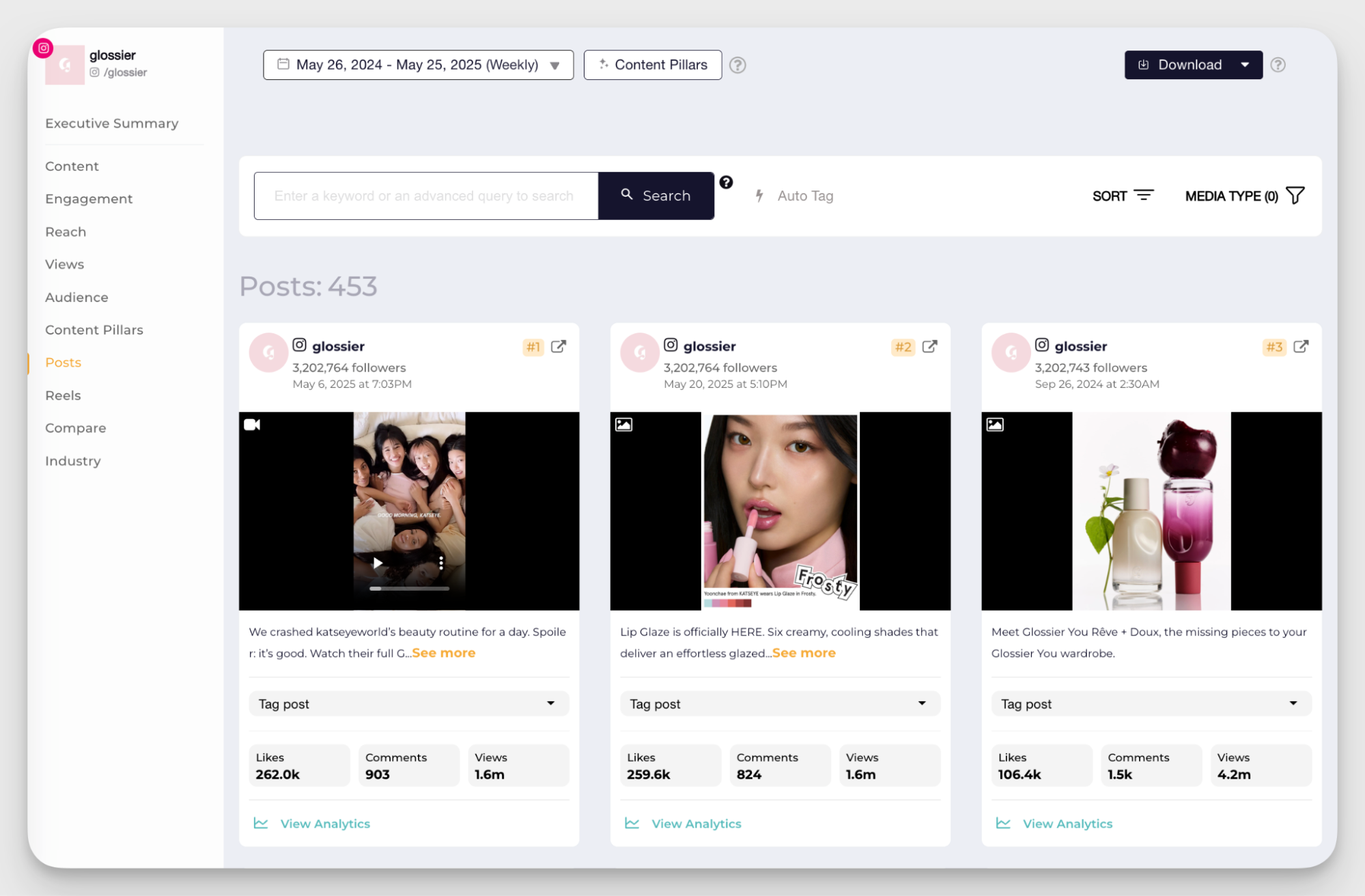
- Email open rates — Email engagement indicates audience interest in your brand messaging and willingness to hear from you regularly.
- Click-through rates (CTR) for ads — Paid content CTR shows whether your messaging resonates with targeted audiences and drives action.
Conversion goals
Conversion metrics directly tie marketing efforts to business outcomes.
What to measure:
- Leads generated — Track both quantity and quality of leads from different channels and campaigns.
- Cost per click (CPC) — Understand the efficiency of your paid campaigns and identify opportunities for optimization.
- Cost per mille (CPM) — Monitor the cost-effectiveness of your reach and awareness campaigns.
Loyalty goals
Loyalty metrics reveal whether customers become long-term advocates for your brand.
What to measure:
- Customer reviews and ratings — Both quantity and sentiment of reviews indicate customer satisfaction and likelihood to recommend.
- Brand mentions and social listening data — Track both volume and sentiment of organic brand mentions across social platforms and the web.
Create a data collection infrastructure
Your framework needs reliable systems for gathering, storing, and accessing data. This infrastructure should integrate multiple data sources while maintaining data quality and accessibility.
- Leverage social media analytics tools that aggregate data from multiple platforms.
- Connect your social media data with web analytics, email platforms, and CRM systems.
- Establish data quality standards and regular auditing processes. Clean, consistent data is essential for accurate analysis and reliable insights.
Develop analysis processes and protocols
Raw data becomes actionable through consistent analysis processes.
- Focus reports on insights. Don't just list numbers. Your reports should answer: What's working, what's not, and what's next? Always include context and recommendations.
- Use hypothesis-driven analysis. Instead of just stating what happened, form and test theories about why performance changed so you can be predictive, not reactive.
- Teach your team to spot trends across time and audience segments, including seasonal shifts, platform behaviors, and audience preferences, to inform future strategy.
Implement insights across marketing channels
The final piece of your framework ensures that insights actually influence marketing decisions. Create a clear process for translating analysis into action:
- Assign team members to monitor key metrics and make adjustments based on performance. Set up escalation processes for major changes.
- Create testing protocols to validate insights before making big changes. Use A/B testing to confirm that observed patterns improve results.
- Connect campaign performance back to analysis. Track which insights led to success and which didn't. This continuous learning refines your framework.
- Document both wins and failures. This builds a knowledge base, helping your team avoid repeating mistakes and understand what truly works.
Challenges of data-driven marketing
While the benefits of data-driven marketing are clear, we know that implementing a successful strategy comes with real obstacles. Here are practical solutions that help social media managers get over common pitfalls.
Data privacy concerns and compliance
Many teams struggle to balance effective social media marketing with privacy regulations like GDPR, CCPA, and changing platform policies.
Solution: Build privacy-first data collection strategies that rely on first-party data and explicit consent. Implement transparent data collection practices and invest in tools that help maintain compliance.
Data quality and integration issues
Marketing managers often work with inconsistent data formats, duplicate records, and missing information, which makes it difficult to create reliable reporting.
Solution: Invest in efficient integration tools that connect multiple data sources. Start with comprehensive social media analytics tools before moving to more complex integration projects.
Skills gaps and team structure
Social media strategists struggle to acquire the analytical skills needed to interpret complex data and turn insights into strategy.
Solution: Invest in training and provide your marketing team with user-friendly analytics tools that don't require advanced technical skills. For example, tools like Socialinsider integrate smart AI insights to quickly and meaningfully interpret data.
Technology selection and implementation
Marketing teams often end up using multiple platforms that don't integrate well and create more confusion than clarity. Implementation timelines stretch longer than expected, and teams don’t get value from their investments.
Solution: Choose tools with strong integration capabilities and APIs that can grow with your needs. Focus on platforms that provide comprehensive insights while offering a user-friendly experience.
Scaling data operations
What works for a small team analyzing basic metrics often breaks down as organizations grow. Manual reporting becomes unsustainable, and data requests pile up fast.
Solution: Automate routine reporting and focus analysis on strategic insights rather than data compilation. Build scalable and accessible systems for social media measurement that can handle growing data volumes.
Data-driven marketing example
At Socialinsider, we practice what we preach when it comes to using data in marketing. Our approach demonstrates how data-driven marketing strategies work in practice.
SEO strategy driven by competitive intelligence
For SEO, we use Ahrefs to track our rankings and compare market share with competitors. This competitive intelligence approach helps us identify gaps and opportunities.
Looking at our SEO performance compared to key competitors, we can see exactly where we stand in the market and which areas need more focus.
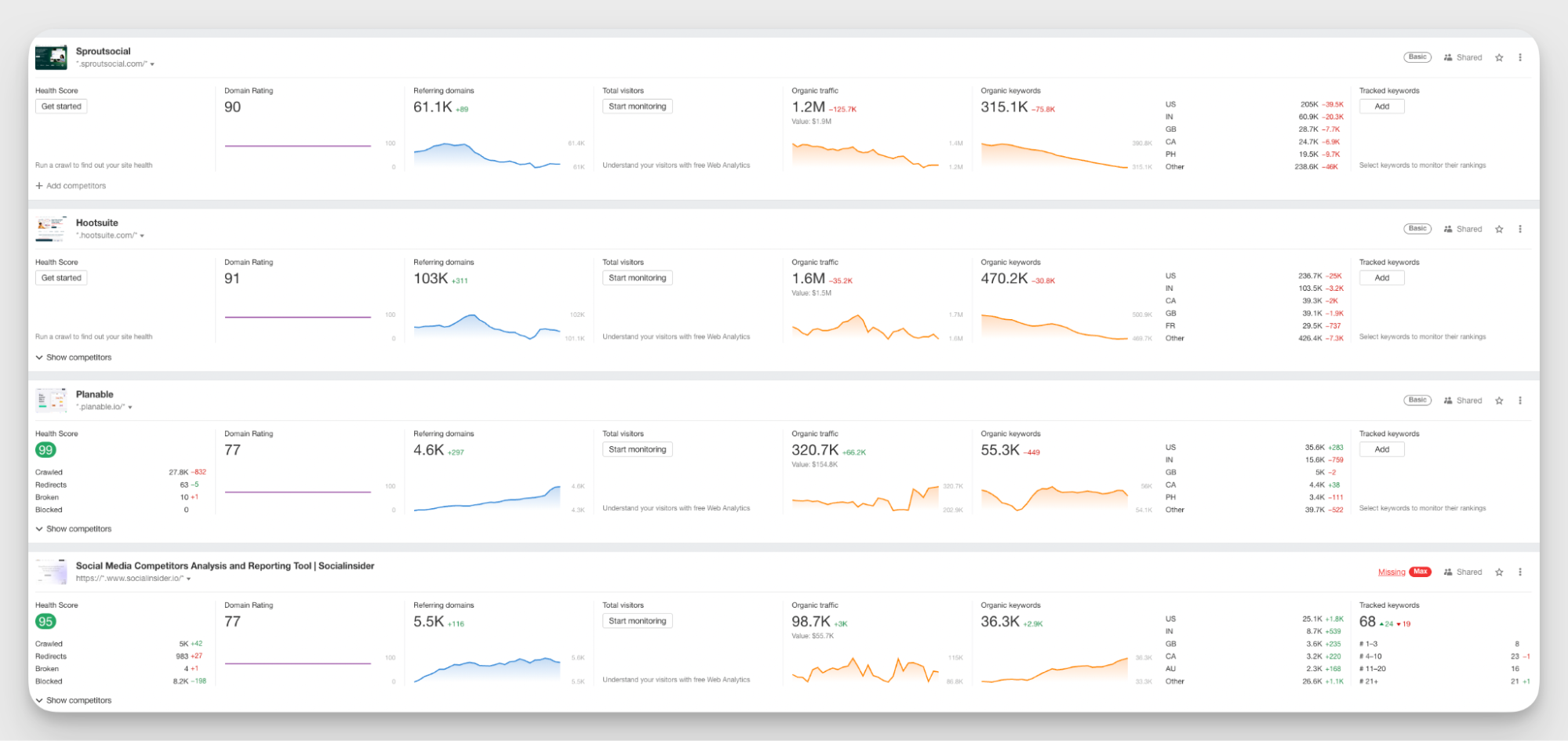
This data reveals performance patterns and helps us prioritize which keywords and content areas deserve more investment. When we see competitors gaining ground in specific areas, we can quickly adjust our content strategy to maintain our competitive position.
LinkedIn strategy powered by performance data
Our LinkedIn strategy is deeply rooted in data, regularly comparing our performance against competitors in the social media analytics space. This approach ensures we're creating content that drives measurable business results.
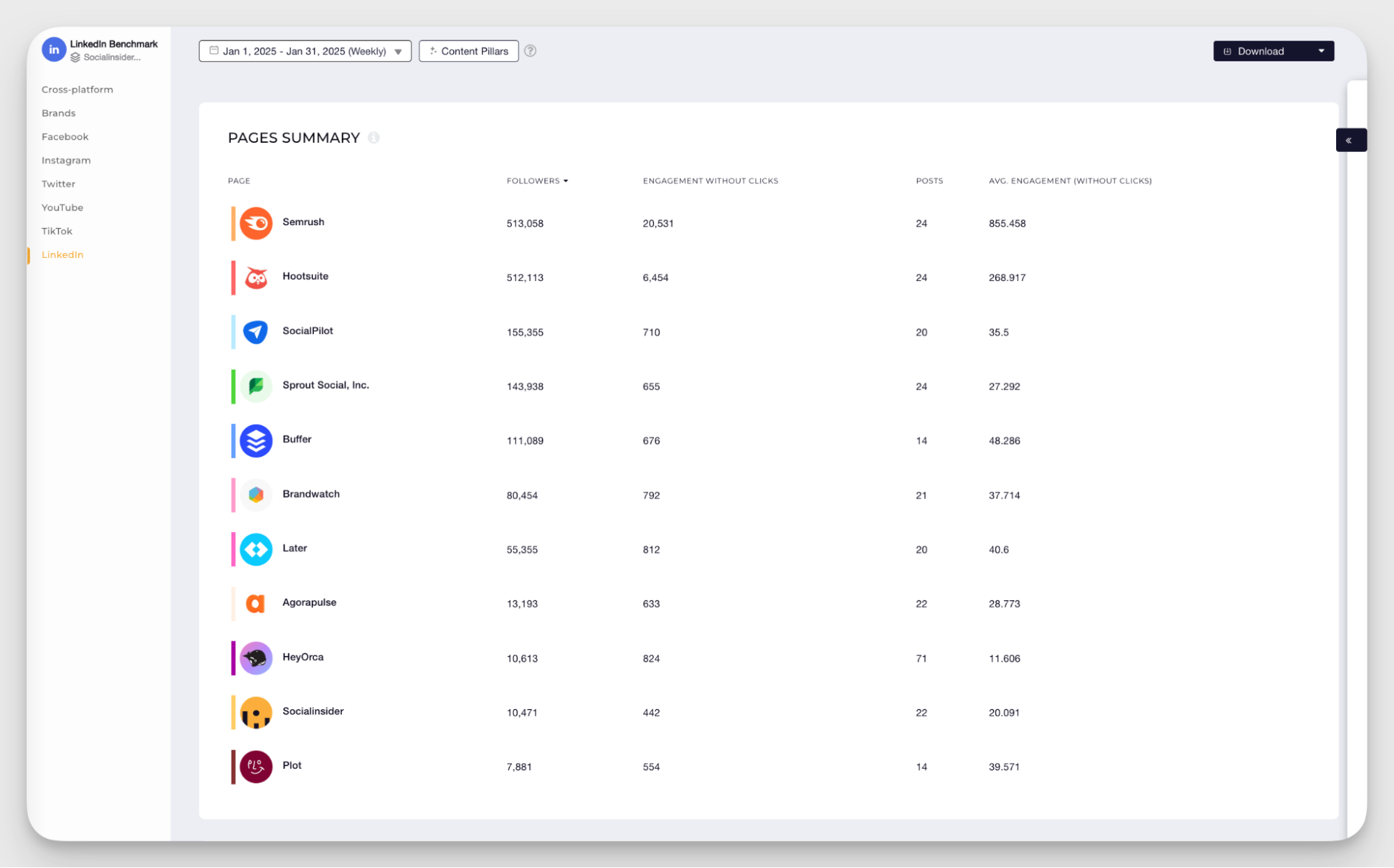
By monitoring how our content performs relative to other brands in our industry, we identify which types of posts generate the most engagement and which topics resonate best with our target audience. This competitive benchmarking helps us stay ahead of industry trends and optimize our messaging.
Content optimization based on pillar performance
We optimize our posting strategy based on the best-performing content pillars, using data to guide both what we create and when we publish it.
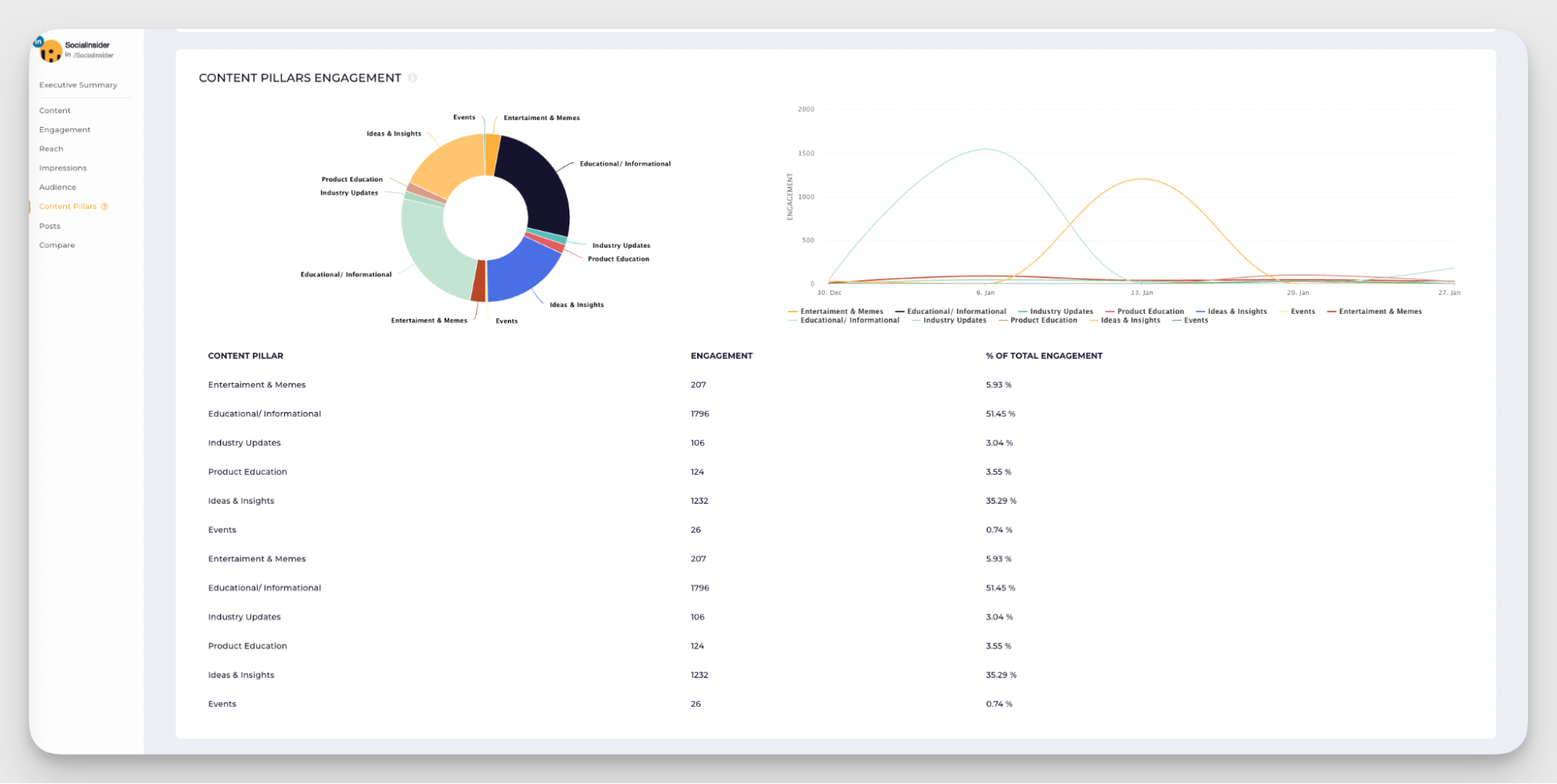
These insights directly inform our content calendar, ensuring we allocate resources to the content types that deliver the strongest performance.
Consistent growth results
This data-driven approach has resulted in continuous growth from both followers and engagement perspectives. Our metrics show the real impact of strategic, data-informed content decisions.
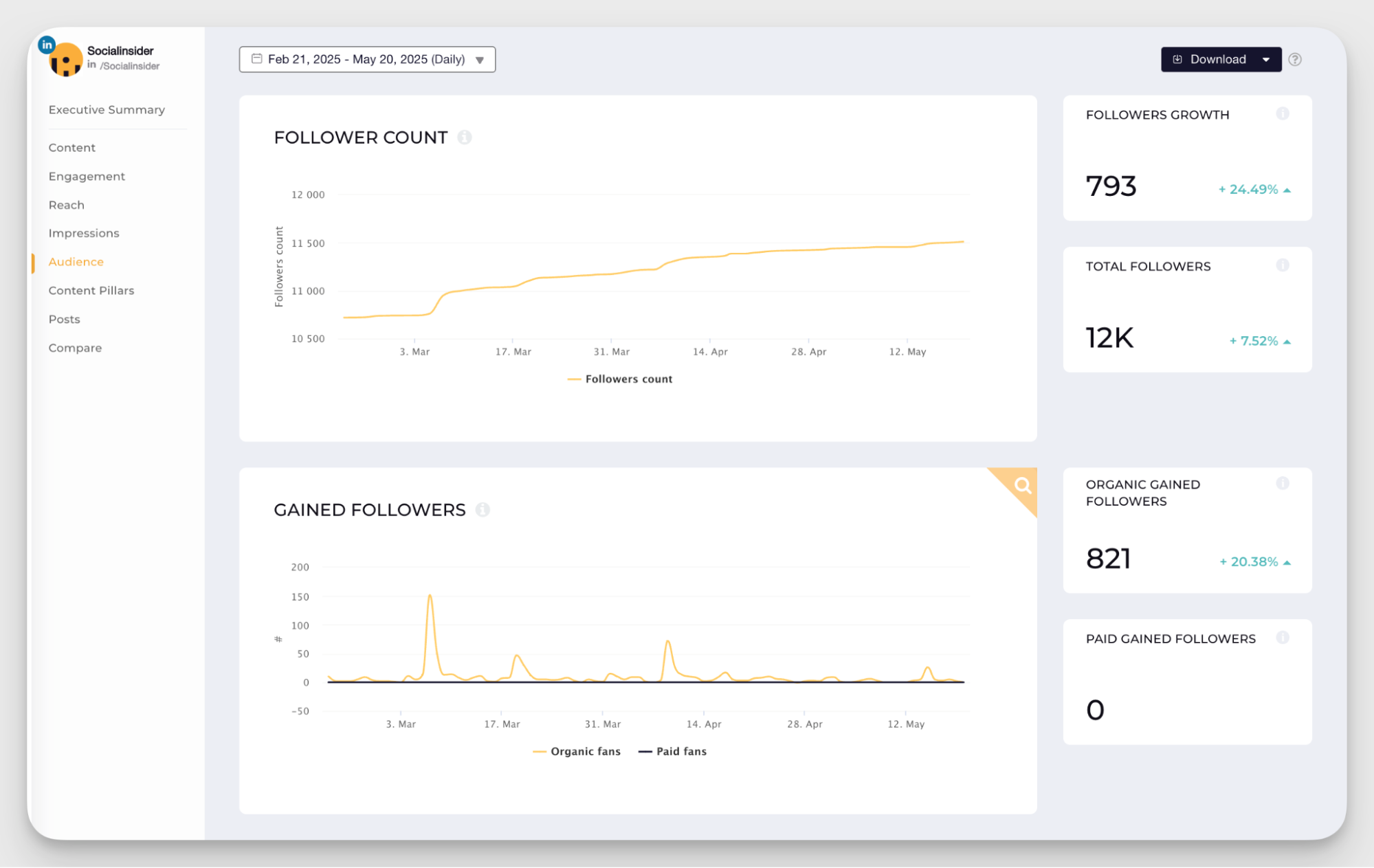
The follower growth data reveals not just overall growth, but also the quality of that growth — 821 organic followers gained versus zero paid followers — indicating our content strategy attracts genuinely interested audiences.

Our engagement metrics tell an even stronger story, with total engagement growing 133% and average engagement per post increasing 140%. The 8.4% engagement rate by followers significantly exceeds LinkedIn benchmarks, demonstrating that our data-driven content strategy creates genuine audience connection.
Key insights
- Regular competitive monitoring — We don't just track our own performance, we constantly benchmark against competitors to identify opportunities and threats.
- Content pillar optimization. Instead of creating content randomly, we let data guide our editorial calendar.
- Growth quality over quantity — Our metrics focus on organic growth and engagement quality, ensuring our audience development supports long-term business goals rather than vanity metrics.
- Integrated analysis — We connect SEO data with social media performance to understand how different channels support each other and contribute to overall marketing objectives.
The key is using data not just to measure what happened, but to inform what happens next.
Trends in data-driven marketing
The role of data in shaping marketing strategies evolves together with platforms and technologies. Here are four key trends that are redefining how brands will leverage data in the years ahead:
- AI and machine learning applications — Artificial intelligence is no longer experimental—it's becoming core to data-driven marketing. From content recommendations and dynamic pricing to automated customer segmentation, AI helps marketers process vast datasets and surface insights faster than ever before.
- Cookieless tracking and privacy-first approaches — With third-party cookies on the way out and stricter data regulations in place, marketers are rethinking how they collect and use data. The shift is toward first-party data, zero-party data, and transparent practices that put user privacy at the center.
- Real-time data processing and implementation — Speed matters. Brands are moving beyond static dashboards toward tools that process and act on data in real time. Whether it's adjusting an ad campaign mid-flight or responding instantly to trending topics, agility is becoming a must-have.
- Predictive customer journey mapping — Rather than just reacting to what users have done, marketers are using predictive analytics to anticipate what they'll do next. This allows for smarter personalization, more timely messaging, and a better experience across the entire customer journey.
Final thoughts
Data-driven marketing isn't about drowning in spreadsheets or becoming a statistics expert. It's about making smarter decisions by using the right frameworks and tools.
Start small, focus on the metrics directly impacting your business goals, and build your data-driven marketing strategy incrementally.
Leverage tools like Socialinsider that make it easy to track social media performance, analyze competitors, and identify successful content strategies. Try it today and see how meaningful reports and insights can quickly improve your social media strategy.
Analyze your competitors in seconds
Track & analyze your competitors and get top social media metrics and more!
You might also like
Improve your social media strategy with Socialinsider!
Use in-depth data to measure your social accounts’ performance, analyze competitors, and gain insights to improve your strategy.




